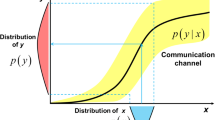Abstract
In this paper, I discuss how information theory has been used in the study of animal communication, as well as how these uses are justified. Biologists justify their use of Shannon’s information measures by the work they do in allowing for comparisons between different organisms and because they measure a quantity that is purported to be important for natural selection. I argue that there are problems with both sorts of justification. To make these difficulties clear, I focus on the use of Shannon’s information measures to quantify the amount of information transmitted by the fire ant’s odor trail and the honeybee’s waggle dance. Both of these systems are relatively simple and well understood, and the application of Shannon’s information measure to these systems initially seemed very promising and relatively straightforward. They are therefore particularly suitable for revealing the benefits and difficulties of applying Shannon’s information measures to biological systems in general, and animal communication systems in particular.
Similar content being viewed by others
References
Allen C, Hauser M (1992) Communication and cognition: Is information the connection?” In: PSA 1992 (Hull DL, Forbes M, Okruhlik K, eds), Vol. 2, 81–91. East Lansing, MI: Philosophy of Science Association.
Beecher MD (1989) Signalling systems for individual recognition: An information theory approach. Animal Behaviour 38: 248–261.
Blumstein DT, Munos O (2005) Individual, age and sex-specific information is contained in yellow-bellied marmot alarm calls. Animal Behaviour 69: 353–361.
Bradbury JW, Vehrencamp SL (1998) Principles of Animal Communication. Sunderland, MA: Sinauer.
Dawkins R, Dawkins M (1973) Decisions and the uncertainty of behavior. Behaviour 45: 83–103.
Dawkins R, Krebs JR (1978) Animal signals: Information or manipulation?” In: Behavioural Ecology (Krebs JR, Davies NB, eds), 282–309. Oxford: Blackwell.
Dusenberry DB (1992) Sensory ecology: How organisms acquire and respond to information. New York: Freeman.
Ficken MS, Hailman ED, Hailman JP (1994) The chick-a-dee call system of the Mexican chickadee. Condor 96: 70–82.
Franks NR (1999) Information flow in the social domain: How individuals decide what to do next. In: Information Processing in Social Insects (Detrain C, Deneubourg J-L, Pasteels JM, eds), 101–112. Basel: Birkhauser.
Fuchs S (1976) An informational analysis of the alarm communication by drumming behavior in nests of carpenter ants. Behavioral Ecology and Sociobiology 1: 315–336.
Gherardi F, Pieraccini R (2004) Using information theory to assess dynamics, structure, and organization of crayfish agonistic repertoire. Behavioural Processes 65: 163–178.
Gould J (1974) Honey bee communication. Nature 252: 300–301.
Gould J (1975) Honey bee recruitment: The dance language controversy. Science 189: 685–693.
Griffiths PE (2001) Genetic information: A metaphor in search of a theory. Philosophy of Science 68: 394–112.
Haldane JBS, Spurway H (1954) A statistical analysis of communication in “Apis Mellifera” and a comparison with communication in other animals. Insectes Sociaux 1: 247–283.
Hauser MD (1996) The Evolution of Communication. Cambridge, MA: MIT Press.
Jablonka E (2002) Information: Its interpretation, its inheritance, and its sharing. Philosophy of Science 69: 578–605.
Levy WB, Baxter RA (2002) Energy-efficient neuronal computation via quantal synaptic failures. Journal of Neuroscience 22: 4746–4755.
MacLaurin J (1998) Reinventing molecular Weismannism: Information in evolution. Biology and Philosophy 13: 37–59.
Markl H (1985) Manipulation, modulation, information, cognition: Some of the riddles of communication. In: Experimental Behavioral Ecology and Sociobiology (Holldobler B, Lindauer M, eds), 163–194. Sunderland, MA: Sinauer.
Martins EP (1994) Structural complexity in the lizard communication system: The Sceloporus graciosus “push-up” display. Copeia 4: 944–955.
McCowan B, Hanser SF, Doyle LR (1999) Quantitative tools for comparing animal communication systems: Information theory applied to bottlenose dolphin whistle repertoires. Animal Behaviour 57: 409–419.
Neih JC, Roubik DW (1998) Potential mechanisms for the communication of height and distance by a stingless bee, Melipona Panamica. Behavioral Ecology and Sociobiology 43: 387–399.
Phelan PL, Baker TC (1990) Information transmission during intra- and interspecific courtship in Ephestia Elutella and Cacra Figulilella. Journal of Insect Behavior 3: 5.
Quastler H (1958) A primer in information theory. In: Symposium on Information Theory in Biology (Yockey HP, Platzman RL, Quastler H, eds), 3–49. New York: Pergamon.
Sarkar S (1996) Biological information: A skeptical look at some central dogmas of molecular biology. In: The Philosophy and History of Molecular Biology: New Perspectives (Sarkar S, ed), 187–232. Dordrecht: Kluwer.
Shannon CE (2001) The bandwagon problems of Information Transmission 37: 89–90; reprinted from IRE Transmission Information Theory, 1956, 2: 3.
Shannon CE, Weaver W (1949) The Mathematical Theory of Communication. Urbana: University of Illinois Press.
Tribus M (1961) Thermostatics and Thermodynamics. Princeton, NJ: van Nostrand.
Wenner AM, Wells PH (1990) Anatomy of a controversy: The question of a “language” among bees. New York: Columbia University Press.
Wilson EO (1962) Chemical communication among workers of the fire ant Solenopsis saevissima (Fr. Smith): 2. An information analysis of the odour trail. Animal Behaviour 10: 148–158.
Wilson EO (1971) The Insect Societies. Cambridge, MA: Harvard University Press.
Wilson EO (1975) Sociobiology: The New Synthesis. Cambridge, MA: Harvard University Press.
Author information
Authors and Affiliations
Corresponding author
Rights and permissions
About this article
Cite this article
Pfeifer, J. The Use of Information Theory in Biology: Lessons from Social Insects. Biol Theory 1, 317–330 (2006). https://doi.org/10.1162/biot.2006.1.3.317
Received:
Accepted:
Published:
Issue Date:
DOI: https://doi.org/10.1162/biot.2006.1.3.317




